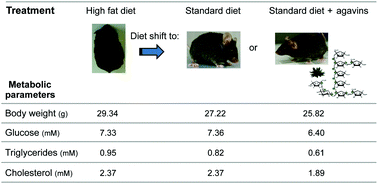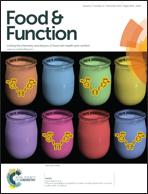Agavins reverse the metabolic disorders in overweight mice through the increment of short chain fatty acids and hormones†
Abstract
In this study, the effects of agavins (branched fructans) along with a diet shift on metabolic parameters, short chain fatty acid (SCFA) production and gastrointestinal hormones in overweight mice were established. Male C57BL/6 mice were fed with a standard (ST) or high fat (HF) diet over the course of 5 weeks, with the objective to induce overweightness in the animals, followed by a diet shift (HF_ST) and a diet shift with agavins (HF_ST + A) or inulin (HF_ST + O) for 5 additional weeks. After the first 5 weeks, the HF group showed a 30% body weight gain and an increase in glucose, triglyceride and cholesterol concentrations of 9%, 79% and 38% respectively when compared to the ST group (P < 0.05). Only the overweight mice that received agavins or inulin in their diets reversed the metabolic disorders induced by consumption of the HF diet, reaching the values very close to those of the ST group (P < 0.05). Furthermore, the consumption of agavins or inulin led to higher SCFA concentrations in the gut and modulated hormones such as GLP-1 and leptin involved in food intake regulation (P < 0.05). These findings demonstrate that a change of diet and fructan consumption such as agavins is a good alternative to increase weight loss and to improve the metabolic disorders associated with being overweight.


 Please wait while we load your content...
Please wait while we load your content...